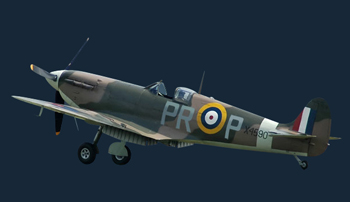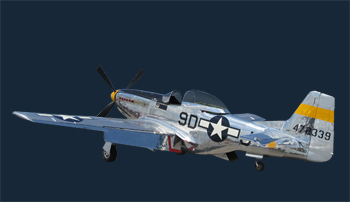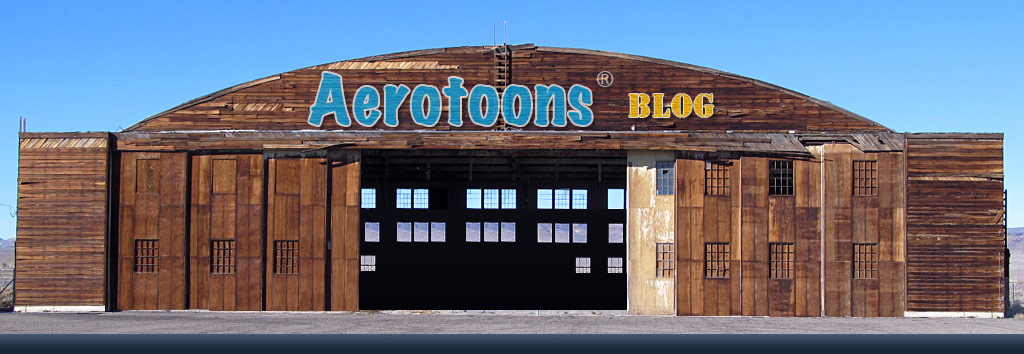Spitfire VS. Mustang

|

|
I have always thought that the World War II British Supermarine Spitfire and the North American P51 Mustang were two of the best looking fighter planes of their time but how did they compare in performance? I thought it would be interesting to take a look at them side by side.
| Supermarine Spitfire Mk VB | North American P51D Mustang |
| • Manufacturer: Supermarine | • Manufacturer: North American Aviation |
| • Crew: 1 | • Crew: 1 |
| • Length: 29 ft 11 in. (9.12 m) | • Length: 32 ft 3 in. (9.83 m) |
| • Height: 11 ft 5 in. (3.86 m) | • Height: 13 ft 4½ in. |
| • Wingspan: 36 ft 10 in. (11.23 m) | • Wingspan: 37 ft 0 in. (11.28 m) |
| • Wing Area: 242.1 ft² (22.48 m²) | • Wing Area: 235 ft² (21.83 m²) |
| • Airfoil: NACA 2213 (root) NACA 2209.4 (tip) | • Airfoil: NAA/NACA 45-100 / NAA/NACA 45-100 |
| • Empty weight: 5,065 lb. (2,297 kg) | • Empty weight: 7,635 lb. (3,465 kg) |
| • Loaded weight: 6,622 lb. (3,000 kg) | • Loaded weight: 9,200 lb. (4,175 kg) |
| • Maximum Takeoff Weight: 6,700 lb. (3,039 kg) | • Maximum Takeoff Weight: 12,100 lb. (5,490 kg) |
| • Powerplant: 1 × Rolls-Royce Merlin 45 supercharged V12 engine, 1,470 hp (1,096 kW) | • Powerplant: 1 × Packard V-1650-7 V-12, with a 2 stage intercooled supercharger- 1,490 hp (1,111 kW) |
| • Variants: 3 | • Variants: 20 |
| • Number built: 20,351 | • Number built: 15,586 |
| • First Flight: March 5 1936 | • First Flight: October 26, 1940 |
| Performance | Performance |
| • Cruise speed: 272 mph (237 kts.) | • Cruise speed: 362 mph (315 kts.) |
| • Maximum speed: 370 mph (322 kts.) | • Maximum speed: 440 mph (383 kts.) |
| • Rate of climb: 2,600 ft/min (13.2 m/s) | • Rate of climb: 3,200 ft/min (16.3 m/s) |
| • Service Ceiling: 36,500 ft. (11,125 m) | • Service Ceiling: 41,900 ft. (12,800 m) |
| • Combat Range: 470 mi. (410 nm.) | • Combat Range: 1,650 mi. (1,434 nm.) with external tanks |
| Armament | Armament |
| • A Wing- 8 x .303 in. Browning MkII machine guns (350 rounds per gun) | • Guns: 6 × 0.50 in. (12.7mm) AN/M2 Browning machine guns with 1,840 total rounds (380 rounds for each on the inboard pair and 270 rounds for each of the outer two pair) |
| • B Wing- 2 x 20 mm Hispano MkII (60 rounds per gun), 4 x .303 in. Browning MkII machine guns (350 rounds per gun) | • Rockets: 6 or 10 × 5.0 in. (127 mm) T64 H.V.A.R rockets (P-51D-25, P-51K-10 on) |
| • C Wing- 4 x 20 mm Hispano MkII cannon (120 rounds per gun) | • Bombs: 1,000 lb (453 kg) total on two wing hardpoints |
| • C Wing (Alt.) 2 x 20 mm Hispano MkII (120 rounds per gun), 4 x .303 in. Browning machine guns (350 rounds per gun) | • Each hardpoint: 1 × 100 lb (45 kg) bomb, 1 × 250 lb (113 kg) bomb or 1 × 500 lb (226 kg) bomb |
| • E Wing- 2 x 20 mm Hispano MkII cannon (120 rounds per gun), 2 x .50 in. Browning machine guns (250 rounds per gun) |
The Spitfire was designed as a short-range, high-performance interceptor aircraft by R. J. Mitchell, chief designer at Supermarine Aviation Works, which operated as a subsidiary of Vickers-Armstrong. Mitchell's design aims were to create a well-balanced, high-performance bomber interceptor and fighter aircraft capable of fully exploiting the power of the Merlin engine, while being relatively easy to fly.
Alex Henshaw, was the chief test pilot at the Castle Bromwich factory. Henshaw wrote: "....I loved the Spitfire in all of her many versions. But I have to admit that the later marks, although they were faster than the earlier ones, were also much heavier and so did not handle so well. You did not have such positive control over them. One test of maneuverability was to throw her into a flick-roll and see how many times she rolled. With the Mark II or the Mark V one got two-and-a-half flick-rolls but the Mark IX was heavier and you got only one-and-a-half. With the later and still heavier versions, one got even less. The essence of aircraft design is compromise, and an improvement at one end of the performance envelope is rarely achieved without a deterioration somewhere else."
The Mustang was an American long-range, single-seat fighter and fighter-bomber designed in 1940 by North American Aviation in response to a requirement of the British Purchasing Commission. The Purchasing Commission approached North American Aviation to build Curtiss P-40 fighters under license for the Royal Air Force but North American Aviation proposed the design and production of a more modern fighter. The prototype NA-73X airframe, designed by a team lead by engineer Edgar Schmued, was rolled out on September 9, 1940, 102 days after the contract was signed, and first flew on October 26, 1940.
The Mustang was originally designed to use the Allison V-1710 engine, which, in its earlier variants, had limited high-altitude performance. In 1942 Ronald Harker, a test pilot for Rolls-Royce suggested fitting a Merlin 61 which dramatically increased the performance and range of the Mustang "B" and later models.
Chief Naval Test Pilot Eric Brown, tested the Mustang at RAE Farnborough in March 1944 and noted, "The Mustang was a good fighter and the best escort due to its incredible range, make no mistake about it. It was also the best American dogfighter. But the laminar flow wing fitted to the Mustang could be a little tricky. It could not by any means out-turn a Spitfire. No way. It had a good rate-of-roll, better than the Spitfire, so I would say the plusses to the Spitfire and the Mustang just about equate. If I were in a dogfight, I'd prefer to be flying the Spitfire. The problem was I wouldn't like to be in a dogfight near Berlin, because I could never get home to Britain in a Spitfire!"
Here is a great book about the Supermarine Spitfire Spitfire: The Legend Lives On by John Dibbs (Author), Tony Holmes (Author)
Here is a great book about the P51 MustangP-51 Mustang: Seventy-Five Years of America's Most Famous Warbird Hardcover – October 19, 2015 by Cory Graff
